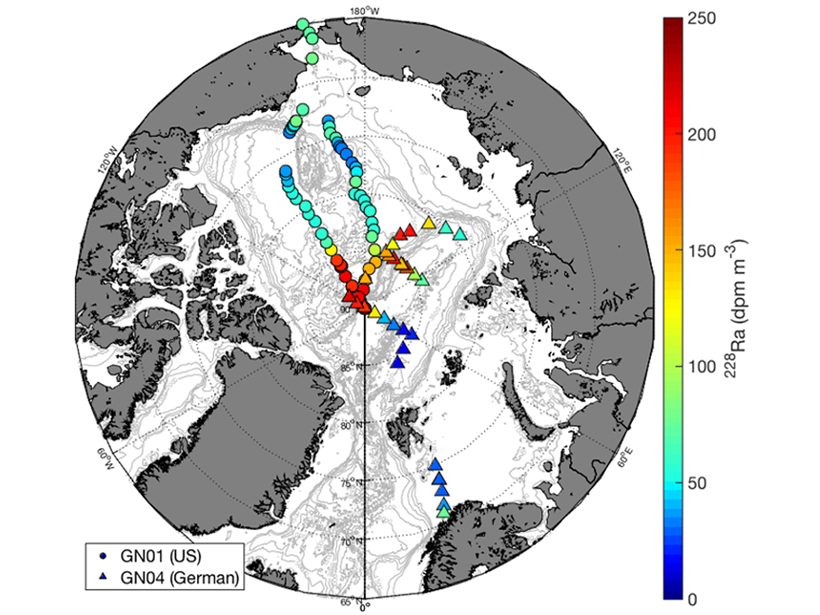Source: Journal of Geophysical Research: Oceans
Radium-228 (228Ra), with a 5.8 year half-life, is produced in sediments by the decay of Thorium-232 (232Th) and released to the pore water. In the Arctic Ocean, the release of 228Ra to the overlying water is known to create a strong 228Ra enrichment over the shallow shelves.
The retreat of Arctic sea ice causes large areas of the Arctic shelf seas to be ice-free over longer periods of the year. In a recent paper, Kipp et al. [2018] argued that a doubling of 228Ra activities, which they observed in 2015 in surface water of the Canadian Basin in the central Arctic Ocean in comparison with data from 2007, indicated that the release rate of 228Ra from Arctic shelves had increased. They argued that this was caused by increased sediment-water interaction. But the accumulation of 228Ra in shelf waters depends on the residence time of water over shallow shelf seas and can therefore vary with water circulation patterns, putting doubt on the interpretation in terms of release rates.
Rutgers van der Loeff et al. [2018] present a new study carried out in the same coordinated GEOTRACES project in 2015. They add data from the Eurasian side of the Arctic Ocean and confirm that the increase of 228Ra in surface waters in 2015 was apparent throughout the Transpolar Drift. This makes it highly unlikely that the change could be due to local variations in water residence time over the shelves and strengthens the case that indeed the 228Ra inputs have increased.
The flux of 228Ra from the sediment pore water to the overlying water depends on the intensity of sediment water interaction, including irrigation and resuspension induced by wave action, processes that are important in shallow waters but reduced by ice cover. It would therefore not be surprising if, as suggested by Kipp et al. [2018], sediment-water exchange on the shelves had increased as a result of longer ice-free seasons. This would have implications for the supply of other terrigenous substances like Iron and dissolved organic carbon to the surface water of the Arctic Ocean.
Citation: Rutgers van der Loeff, M., Kipp, L., Charette, M. A., Moore, W. S., Black, E., Stimac, I., et al. [2018]. Radium isotopes across the Arctic Ocean show time scales of water mass ventilation and increasing shelf inputs. Journal of Geophysical Research: Oceans, 123. https://doi.org/10.1029/2018JC013888
—Peter Brewer, Editor-in-Chief, JGR: Oceans
Text © 2018. The authors. CC BY-NC-ND 3.0
Except where otherwise noted, images are subject to copyright. Any reuse without express permission from the copyright owner is prohibited.

